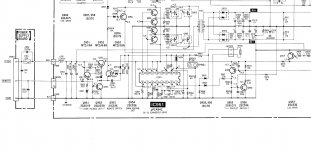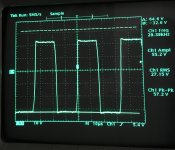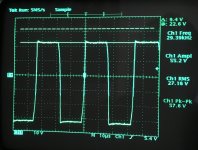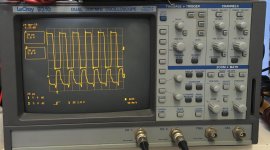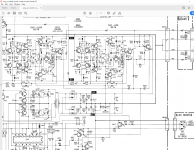Further to my poking around inside a Sony XM 6020 I have discovered that the positive rail potential is ~33% lower than the negative rail's potential to ground.
The positive rail measures at around +22 v whereas the negative rail measures at -32 v.
I have noticed that the filter capacitor on the negative rail is also warmer than the capacitor on the positive rail.
The spec given in the service manual is +32/-32 volts.
The voltages at the drains of the mosfets just before the transformer are identical.
The square wave taken from the anodes of the rectifiers seems to be "offset" low, if that makes sense?
Is the problem in the rectifier diodes, it seems unlikely to be the transformer isn't is?
The positive rail measures at around +22 v whereas the negative rail measures at -32 v.
I have noticed that the filter capacitor on the negative rail is also warmer than the capacitor on the positive rail.
The spec given in the service manual is +32/-32 volts.
The voltages at the drains of the mosfets just before the transformer are identical.
The square wave taken from the anodes of the rectifiers seems to be "offset" low, if that makes sense?
Is the problem in the rectifier diodes, it seems unlikely to be the transformer isn't is?
Attachments
Last edited:
Member
Joined 2009
Paid Member
that power supply schematic suggests that the rails should be symmetrical and hence either a) somewhere excess current draw is pulling it down or b) rectifier / caps are not doing their job. If you measure across L901 you might get some idea of how much current is returning through the gnd, if the amp is symmetrical it should be very little if there's a lot of current there then something is pulling the rail down.
that power supply schematic suggests that the rails should be symmetrical and hence either a) somewhere excess current draw is pulling it down or b) rectifier / caps are not doing their job. If you measure across L901 you might get some idea of how much current is returning through the gnd, if the amp is symmetrical it should be very little if there's a lot of current there then something is pulling the rail down.
I'm sorry but I can't find an Inductor marked "L901" on the schematic. There are two inductors in the output stage marked "L101" and "L201", have I missed something?
Some of the MOSFET's get hotter than others? One of the arms may be faulty, or the gate resistor altered.
The mosfets on the (+) rail in question are stone cold (running at idle with no input signal) whereas the mosfets on the chanel with the normal (-)rail voltage are just ever so slighgtly warmer.
The gate resistors look orginal, as does everything else in this amp, I can measure them in circuit to see if they are out of spec.
Should I do this with the power off or on?
Yes, I posted the gate signals in another post:
Bottom is gate and top is drain. All measure the same in shape and magnitude.
I have also found that there is a potential of around -4.8 v between the battery negative input and the centre terminal of the transformer on the rectifier side.
The gate resistors measure within tolerance.
Bottom is gate and top is drain. All measure the same in shape and magnitude.
I have also found that there is a potential of around -4.8 v between the battery negative input and the centre terminal of the transformer on the rectifier side.
The gate resistors measure within tolerance.
Attachments
Last edited:
I'm sorry but I can't find an Inductor marked "L901" on the schematic. There are two inductors in the output stage marked "L101" and "L201", have I missed something?
Edit:
I did miss it, apologies Bigun.
It is glued to the board however and I cannot make any measurements without taking the board off the heat sinks, it does not seem to get particularly hot however.
Last edited:
Check L901, between the 'lytics. May be open circuited.
It is not possible to measure it's resistance directly from the top of the board but measuring between the transfomer centre connection and "blu" and "brn" on the speaker output board gives a resistance of 0.5 ohms.
That's low but is it a short?
Attachments
Don't worry, this is why I'm here.Thank you for your continuing help by the way Osvaldo, very much appreciated.
I was thinking where are the measurement made. The oscillo and the voltmeter, respectively, if to bat ground or amp ground.
In other hands, I don't understand why to separate both systems, useless for me.
- Status
- This old topic is closed. If you want to reopen this topic, contact a moderator using the "Report Post" button.
- Home
- General Interest
- Car Audio
- Positive power supply rail at a different potential than negative rail?
